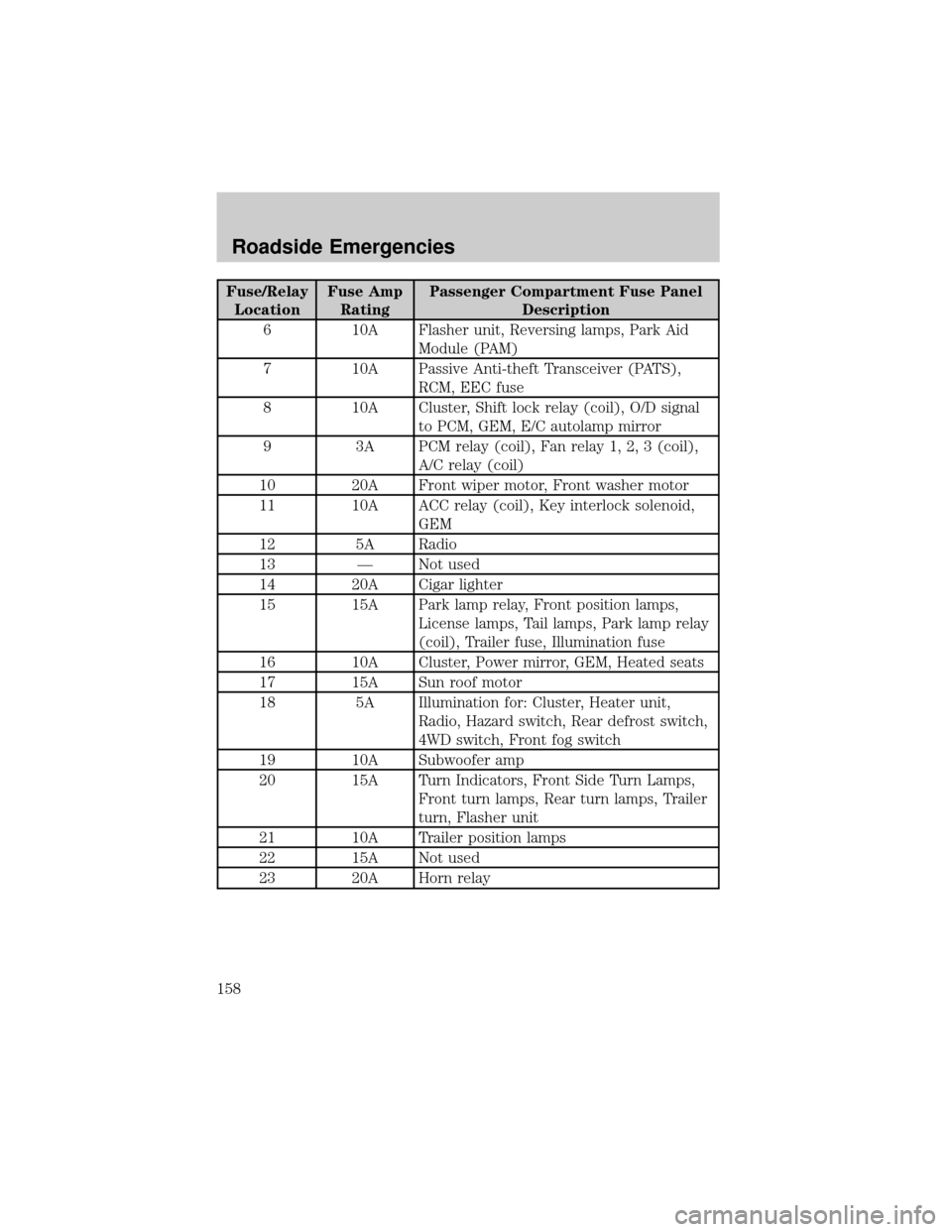2003 MAZDA MODEL TRIBUTE heater
[x] Cancel search: heaterPage 41 of 248

²A disc with format and dimensions not within industry standards is
inserted.
CD units are designed to play commercially pressed 12 cm (4.75
in) audio compact discs only. Due to technical incompatibility,
certain recordable and re-recordable compact discs may not
function correctly when used in Mazda CD players. Irregular
shaped CDs, CDs with a scratch protection film attached, and CDs
with homemade paper (adhesive) labels should not be inserted
into the CD player. The label may peel and cause the CD to
become jammed. It is recommended that homemade CDs be
identified with permanent felt tip marker rather than adhesive
labels. Ball point pens may damage CDs. Please contact your
dealer for further information.
CD TIPS - CONDENSATION PHENOMENON
Immediately after turning on the heater when the vehicle is cold, the CD
or optical components (prism and lens) in the CD player/changer may
become clouded with condensation. When this happens, the CD will eject
immediately when placed in the unit. A clouded CD can be corrected
simply by wiping it with a soft cloth. Clouded optical components will
clear naturally in about an hour. Wait for normal operation to return
before attempting to use the unit.
HANDLING THE IN-DASH CD PLAYER
²Do not spill any liquid on the audio system.
²Do not insert any objects, other than CDs, into the slot.
²The CD revolves at a high speed within the unit. Defective (cracked or
badly bent) CDs should never be used.
²Do not use non-conventional discs such as heart-shaped, octagonal
discs, etc. The CD player could be damaged.
²A new CD may have rough edges on its inner and outer perimeters. If
a disc with rough edges is used, proper setting will not be possible
and the CD player will not play the CD. Remove the rough edges in
advance by using a ball-point pen or pencil as shown above. To
remove the rough edges, rub the side of the pen or pencil against the
inner and outer perimeter of the CD.
²
When driving over rough or uneven surfaces, the audio sound may jump.
²The CD player has been designed to play CDs bearing the
identification logo as shown. No other discs can be played.
Entertainment Systems
41
Page 123 of 248

1. Turn the key to 4 (START)
without pressing the accelerator
pedal and release as soon as the
engine starts. The key will
return to 3 (ON).
2. If the temperature is above
±12ÉC (10ÉF) and the engine
does not start within five
seconds on the first try, turn the
key to OFF, wait 10 seconds and
try again.
3. If the temperature is below -12É C (10É F) and the engine does not
start in 15 seconds on the first try, turn the key OFF and wait 10
seconds and try again. If the engine does not start in two attempts,
press the accelerator pedal all the way to floor and hold. Turn the
key to START position.
4. When the engine starts, release the key, then release the accelerator
pedal gradually as the engine speeds up.
5. After idling for a few seconds, apply the brake, shift into gear and
drive.
Using the engine block heater (if equipped)
An engine block heater warms the engine coolant, which improves
starting, warms up the engine faster and allows the heater-defroster
system to respond quickly. Use of an engine block heater is strongly
recommended if you live in a region where temperatures reach -23É C
(-10É F) or below.
For best results, plug the heater in at least three hours before starting
the vehicle. Using the heater for longer than three hours will not harm
the engine, so the heater can be plugged in the night before starting the
vehicle.
WARNING: To prevent electrical shock, do not use your heater
with ungrounded electrical systems or two-pronged (cheater)
adapters.
Guarding against exhaust fumes
Although odorless and colorless, carbon monoxide is present in exhaust
fumes. Take precautions to avoid its dangerous effects.
Driving
123
Page 158 of 248

Fuse/Relay
LocationFuse Amp
RatingPassenger Compartment Fuse Panel
Description
6 10A Flasher unit, Reversing lamps, Park Aid
Module (PAM)
7 10A Passive Anti-theft Transceiver (PATS),
RCM, EEC fuse
8 10A Cluster, Shift lock relay (coil), O/D signal
to PCM, GEM, E/C autolamp mirror
9 3A PCM relay (coil), Fan relay 1, 2, 3 (coil),
A/C relay (coil)
10 20A Front wiper motor, Front washer motor
11 10A ACC relay (coil), Key interlock solenoid,
GEM
12 5A Radio
13 Ð Not used
14 20A Cigar lighter
15 15A Park lamp relay, Front position lamps,
License lamps, Tail lamps, Park lamp relay
(coil), Trailer fuse, Illumination fuse
16 10A Cluster, Power mirror, GEM, Heated seats
17 15A Sun roof motor
18 5A Illumination for: Cluster, Heater unit,
Radio, Hazard switch, Rear defrost switch,
4WD switch, Front fog switch
19 10A Subwoofer amp
20 15A Turn Indicators, Front Side Turn Lamps,
Front turn lamps, Rear turn lamps, Trailer
turn, Flasher unit
21 10A Trailer position lamps
22 15A Not used
23 20A Horn relay
Roadside Emergencies
158
Page 163 of 248

WARNING: Steam from an overheated engine is dangerous. The
escaping steam could seriously burn you. Open the hood ONLY
after steam is no longer escaping from the engine.
4. Check whether coolant or steam is escaping from under the hood or
from the engine compartment.
²If steam is coming from the engine compartment:do not go near
the front of the vehicle. Stop the engine, then turn the ignition switch
to the ON position without starting the engine. The radiator cooling
fans will start to cool the engine.
²If neither coolant nor steam is escaping:open the hood and idle
the engine until it cools. If this does not lower the temperature, stop
the engine and let it cool.
5. Check the coolant level. If it is low, look for leaks in the radiator
hoses and connections, heater hoses and connections, radiator and
water pump.
If you find a leak or other damage, or if coolant is still leaking, stop the
engine and call an Authorized Mazda dealer.
SeeAdding coolantin theMaintenance and specificationssection. If
you find no problems, the engine is cool and no leaks are obvious,
carefully add coolant as required.
WARNING: When the engine and radiator are hot, scalding
coolant and steam may shoot out under pressure and cause
serious injury. Do not remove the cooling system cap when the
engine and radiator are hot.
Note:If the engine continues to overheat or frequently overheats, have
the cooling system inspected. The engine could be seriously damaged
unless repairs are made.
TEMPORARY SPARE TIRE INFORMATION
The temporary spare tire for your vehicle is labeled as such. It is smaller
than a regular tire and is designed for emergency use only.
WARNING: If you use the temporary spare tire continuously or
do not follow these precautions, the tire could fail, causing you
to lose control of the vehicle, possibly injuring yourself or
others.
Roadside Emergencies
163
Page 169 of 248

JUMP STARTING YOUR VEHICLE
WARNING: The gases around the battery can explode if
exposed to flames, sparks, or lit cigarettes. An explosion could
result in injury or vehicle damage.
Do not push start your vehicle. You could damage the catalytic
converter.
WARNING: Batteries contain sulfuric acid which can burn skin,
eyes and clothing, if contacted.
Do not attempt to push start your vehicle. Automatic
transmissions do not have push-start capability.
Preparing your vehicle
When the battery is disconnected or a new battery is installed, the
transmission must relearn its shift strategy. As a result, the transmission
may have firm and/or soft shifts. This operation is considered normal and
will not affect function or durability of the transmission. Over time, the
adaptive learning process will fully update transmission operation.
²Use only a 12±volt supply to start your vehicle.
²Do not disconnect the battery of the disabled vehicle as this could
damage the vehicle's electrical system.
²Park the booster vehicle close to the hood of the disabled vehicle
making sure the two vehiclesdo nottouch. Set the parking brake on
both vehicles and stay clear of the engine cooling fan and other
moving parts.
²Check all battery terminals and remove any excessive corrosion before
you attach the battery cables. Ensure the vent caps are tight and
level.
²Turn the heater fan on in both vehicles to protect any electrical
surges. Turn all other accessories off.
Roadside Emergencies
169
Page 241 of 248

Cleaning your vehicle
engine compartment ..............188
instrument panel ....................190
interior .....................................190
interior trim ............................190
Mazda car care products .......191
plastic parts ............................189
washing ....................................187
waxing .....................................187
wheels ......................................188
wiper blades ............................189
Climate control (see Air
conditioning or Heating) ............44
Clock ......................................26, 39
Clutch
fluid ..........................................228
operation while driving ..........134
recommended shift speeds ....135
Console ........................................66
overhead ....................................58
Controls
power seat .................................81
Coolant
checking and adding ..............209
refill capacities ................213, 234
specifications ..........................236
Cruise control
(see Speed control) ....................62
Customer
Assistance ..................176±177, 180
D
Daytime running lamps
(see Lamps) ................................48
Defrost
rear window ..............................47Dipstick
automatic transmission
fluid ..........................................226
engine oil .................................203
Driving under special
conditions ..................133, 140, 143
sand .........................................142
snow and ice ...........................144
through water .................142, 147
E
Emergencies, roadside
jump-starting ..........................169
Emission control system ..........222
Engine ........................................236
cleaning ...................................188
coolant .....................................209
idle speed control ...................207
lubrication specifications .......236
refill capacities ........................234
service points ..................200±201
Engine block heater .................123
Engine oil ..................................203
checking and adding ..............203
dipstick ....................................203
filter, specifications ................206
recommendations ...................206
refill capacities ........................234
specifications ..........................236
Exhaust fumes ..........................123
F
Fluid capacities .........................234
Foglamps .....................................48
Four-Wheel Drive vehicles
description ..............................138
driving off road .......................139
indicator light .........................138
Index
241